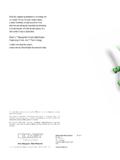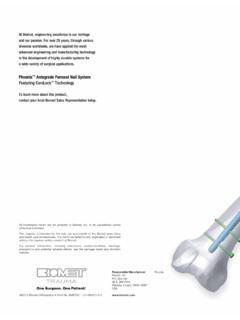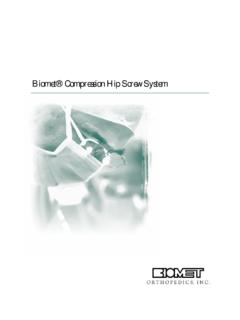Transcription of VPC (Variable Pitch Compression) Screw System
1 Surgical TechniqueVPC (Variable Pitch Compression) Screw SystemContentsIntroduction .. Page 1 Product Description .. Page 2 Indications .. Page 3 Classification Of Scaphoid Fractures .. Page 4 Surgical TechniquePatient Preparation .. Page 6 Guide Wire Placement .. Page 8 VPCS crew Insertion (Mini Screw ) .. Page 9 Closure And Post Operative Care .. Page 10 Percutaneous And ArthroscopicallyAssisted Techniques .. Page 11 Mini VPCS crews And Instruments .. Page 12 Micro VPCS crews And Instruments .. Page 13 VPCS crew System : Universal Instruments .. Page 14 References .. Page 16 Further Information .. Page 17 IntroductionThe VPC (Variable Pitch Compression) Screw is a stainlesssteel variable Pitch Screw designed to provide stablefixation and compression of small bone fragments where aprotrusive Screw head is undesirable.
2 The combination of asmall diameter and non-threaded central portion minimizesthe amount of bone sacrificed during a surgical VPC Screw is indicated for fusions, fractures orosteotomies of the upper and lower extremities. Micro VPC ScrewsThe VPC Screw is available in a smaller, noncannulatedmicro bone Screw version. The Micro VPCS crew is aheadless Screw with two differing thread pitches to allowfor compression between bone fragments. Micro VPCS crews are available in the sizes/lengths referenced on page VPC Screws The Mini VPCS crew is a cannulatedheadless Screw , with two differing thread pitches to allow for compressionbetween bone fragments. Mini VPCS crews are available inthe sizes/lengths referenced on page VPCS crew FamilyProduct Description2 Screw TypeProximal DiametersProximal PitchShaft DiameterDistal DiametersDistal Pitch (A)(B)(C)(D)(E)Mini VPCS crewsMajor Diameter = to Diameter = (cannulated)Minor Diameter = to Diameter = (A) Screw Length** (D)Proximal DiametersDistal Diameters(B) (C)(E)Proximal PitchShaft DiameterDistal Pitch **Mini VPCS crews are available in lengths 12mm to 30mm (increments of ) Screw TypeProximal DiametersProximal PitchShaft DiameterDistal DiametersDistal Pitch (A)(B)(C)(D)(E)Micro VPCS crews Major Diameter = to Diameter = (non-cannulated)
3 Minor Diameter = to Diameter = (A) Screw Length* (D)Proximal DiametersDistal Diameters(B) (C)(E)Proximal PitchShaft DiameterDistal Pitch *Micro VPCS crews are available in lengths 12mm to 26mm (increments of )IndicationsFixation of scaphoid fractures and nonunions, osteotomies and fractures of the carpus and hand or foot, intra-articular fractures, osteochondral fractures, and small joint biomechanical and vascular characteristics of the scaphoid result in a relatively high incidence of complications associated with fracture. Anatomicreduction and stable internal fixation of displaced scaphoid fractures has been shown to increase the rate of union and limit the sequelae associated with these difficult fractures.
4 fixation of nondisplaced unstable fractures has also been advocated in some clinical situations to limit the need for immobilizationenhancing a more rapid functional recovery. In the settingof an established scaphoid nonunion, open reduction inconjunction with cancellous or cortico-cancellous bonegrafting and internal fixation has been shown to result in ahigh rate of union restoring intercarpal relationships in anattempt to prevent or delay degenerative avoiding the use of plaster or fiberglass, early(protected) joint motion is possible. There appears to be accelerated bone healing which could lead to a more rapid functional recovery. The complications ofplaster, joint stiffness, osteoporosis, and muscleatrophy are avoided. Internal fixation using the VPC Screw is indicated in the treatment of all acute, unstablefractures (Type B) of the scaphoid, or whenever prolongedplaster or fiberglass immobilization is , internal fixation has proven to be invaluable as anadjunct to bone grafting for scaphoid nonunion (Type C).
5 3 The scaphoid bone is in the most lateral (radial) position in the proximal row of wrist bones. It is a common fracturesite (from falling on an outstretched arm) and frequentlyhas healing complications due to poor blood supply. The following classification of scaphoid fractures isrecommended:Type A1:Fracture of the TubercleType A: Acute, StableUnion may be expected after immobilization of the wrist forsix weeks in a Colles-type plaster or fiberglass. However,internal fixation may be indicated when the patient declinesthe use of plaster or A2:Incomplete Fracture Through WaistClassification Of Scaphid Fractures4 Type B: Acute, UnstableOpen reduction and Screw fixation are indicated in comminuted fractures; supplementary bone grafting may be required.
6 In obliquefractures, additional k-wires fixation may be B1:Type B2:Type B3:Type B4:Distal Oblique FractureComplete Fracture of WaistProximal Pole FractureTransscaphoid - PerilunateFracture Dislocationof Carpus5 Type C: Delayed UnionScrew fixation , with or without bone grafting, is , it is recommended to leave the wrist free of plaster or fiberglass for a minimum of two weeks prior to D1: Fibrous NonunionThe fibrous tissue should be completely excised and suitable bone graft (cancellous or cortico-cancellous) inserted prior toscrew D2: PseudarthrosisReconstruction of the scaphoid involves resection of thepseudarthrosis and correction of the deformity, using a substantial cortico-cancellous bone graft from the iliac is only indicated after careful assessment of the patient s expectations and PreparationThe patient is positioned supine with a radiolucent handtable.
7 General or regional anesthesia is recommended. A proximal pneumatic tourniquet is utilized and the arm isprepped and draped in the usual orthopedic fashion. If theneed for an iliac crest bone graft is anticipated, the chosenanterior iliac crest is prepped and draped. Exposure may be facilitated by a small bump placed beneath the ApproachThe majority of displaced scaphoid fractures areapproached volarly. This facilitates fracture visualization and reduction without risk of compromising the dorsalvasculature. The volar approach also allows for thecorrection of the classic apex dorsal or humpback deformity associated with scaphoid nonunions in additionto allowing optimal bone graft skin incision is centered over the scaphoid tuberosity,which is easily palpated.
8 The incision is made just radial to the Flexor Carpi Radialis (FCR) tendon curving radially at the wrist flexion crease. The superficial palmar branch of the radial artery will be encountered crossing the surgicalfield and should be Technique6 The FCR tendon sheath is incised and the tendon retractedulnarly. The floor of the sheath is incised over the scaphoidtuberosity and extended proximally into a wrist adequately visualize the proximal scaphoid it will benecessary to incise the volar radioscaphocapitate should be repaired at the time of capsular , the incision should be extended splitting the thenarmusculature in line with the fibers to expose the entirescaphoid tuberosity and the trapezial articulation. Theexposure is facilitated by positioning and maintaining thewrist in a dorsiflexed position.
9 Care should be taken not todissect dorsally, placing the vascular supply at risk, and thescapholunate ligament should not be disrupted withproximal fracture can now be visualized and the hematoma andfibrous tissue gently irrigated and debrided. The fracture is anatomically reduced under direct vision and reductionconfirmed fluoroscopically. Reduction can be facilitated by the curved 9mm spoon or the dual elevator in the set,which is optimally placed radically at the waist to affect andmaintain a reduction. In the setting of a nonunion, allfibrous tissue is debrided and the bone curetted of cystictissue. The deformity is then reduced and the defecttemplated for a graft. The graft should be seated prior to pin placement to allow capture if ApproachProximal pole fractures and non-displaced waist fracturesare best approached proximal pole is localizedfluoroscopically and a incision is placed distal to Lister s tubercle.
10 Dissection is carried through thesubcutaneous tissues with care to protect branches of thesuperficial radial interval lies between the tendons of the third and fourthcompartments. The extensor retinaculum is opened and theExtensor Pollicis Longus (EPL), Extensor Carpi RadialisLongus (ECRL) and Extensor Carpi Radialis Brevis (ECRB)tendons are retracted radially and the Extensor DigitorumCommunis (EDC) tendons retracted ulnarly (Image 1a).The capsule is incised longitudinally over the proximal polewith care to protect the scapholunate ligament and thevasculature of the dorsal ridge. The fracture is visualizedand anatomically reduced. Visualization of the fracture andguide wire placement is facilitated by palmar flexion of thewrist. The starting point is ulnar near the scapholunateligament (Image 1b).






